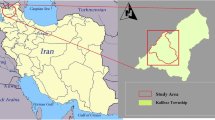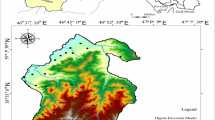Abstract
The Bharathapuzha river basin, once endowed with dense vegetation and abundant water, has been experiencing acute water shortage and extreme climatic conditions in recent times. To understand the influence of human interventions on the natural environmental conditions, including the problems mentioned above, it is essential to critically examine the changes in land use/cover over these years. The objective of this study is to assess land use/cover change in the Bharathapuzha river basin, Kerala during the period 1990–2017 using LANDSAT series satellite images. The dynamics of land use/cover change were quantified and mapped using geospatial techniques. The multi-temporal LANDSAT images were classified by supervised maximum likelihood method to generate the corresponding land use/cover maps; changes in land use/cover in the river basin were subsequently detected by the post-classification technique. Results of the study revealed a drastic change in land use/cover in the period 1990–2017; the primary causes of this were deforestation and urbanization. The near- and long-term future land use/cover maps of the basin for 2020 and 2035 were generated from the historically retrieved land use/cover change pattern. Multi-Layer Perceptron Neural Network and Markov chain techniques were used to generate future land use/cover maps. These maps reveal that the predominant land use/cover class in the basin will be barren land and about 46.13% of the existing (in 2017) dense vegetation will diminish by 2035. The efficiency of sustainable watershed management activities in the river basin can be improved based on the critical observations from this study.








Similar content being viewed by others
Explore related subjects
Discover the latest articles, news and stories from top researchers in related subjects.References
Betts, R. A., Falloon, P. D., Goldewijk, K. K., & Ramankutty, N. (2007). Biogeophysical effects of land use on climate: model simulations of radiative forcing and large-scale temperature change. Agricultural and Forest Meteorology, 142, 216–233.
Bezold M, Minker W (2011) Adaptive multimodal interactive systems. New York: Springer Science & Business Media.
Bhatta, B. (2008). Remote sensing and GIS. New Delhi: Oxford University Press.
Bonan, G. B. (2008). Forests and climate change: forcings, feedbacks, and the climate benefits of forests. Science, 320, 1444–1449.
Bridges, E. M. (1998). World reference base for soil resources (2nd ed.). Atlas: Acco.
Butt, A., Shabbir, R., Ahmad, S. S., & Aziz, N. (2015). Land use change mapping and analysis using Remote Sensing and GIS: a case study of Simly watershed, Islamabad, Pakistan. Egyptian Journal of Remote Sensing and Space Science, 18, 251–259.
Chen, R., Sung, W.-P., & Kao, J. C. (2012). Frontiers of energy and environmental engineering. CRC Press.
Coppin, P., Lambin, E., Jonckheere, I., & Muys, B. (2002). Digital change detection methods in natural ecosystem monitoring: a review. In Analysis of multi-temporal remote sensing images (pp. 3–36). World Scientific.
Council NR, & Committee, G. S. (2014). Advancing land change modeling: opportunities and research requirements. National Academies Press.
de Almeida, C. M., Batty, M., Monteiro, A. M. V., Câmara, G., Soares-Filho, B. S., Cerqueira, G. C., & Pennachin, C. L. (2003). Stochastic cellular automata modeling of urban land use dynamics: empirical development and estimation. Computers, Environment and Urban Systems, 27, 481–509.
DeFries, R., & Belward, A. (2000). Global and regional land cover characterization from satellite data: an introduction to the special issue. International Journal of Remote Sensing, 21, 1083–1092.
Deng, X., Güneralp, B., & Su, H. (2014). Systematic modeling of land use impacts on surface climate. In Land use impacts on climate (pp. 1–17). Springer.
Dewan, A. M., & Yamaguchi, Y. (2009). Using remote sensing and GIS to detect and monitor land use and land cover change in Dhaka Metropolitan of Bangladesh during 1960–2005. Environmental Monitoring and Assessment, 150, 237–249.
Eastman J (2015a) TerrSet: geospatial monitoring and modeling software—Clark Labs, Clark University.
Eastman JR (2015b) TerrSet manual. Accessed in TerrSet version 18:1–390.
Feddema, J. J., Oleson, K. W., Bonan, G. B., Mearns, L. O., Buja, L. E., Meehl, G. A., & Washington, W. M. (2005). The importance of land-cover change in simulating future climates. Science, 310, 1674–1678.
Foley, J. A., Defries, R., Asner, G. P., Barford, C., Bonan, G., Carpenter, S. R., Chapin, F. S., Coe, M. T., Daily, G. C., Gibbs, H. K., Helkowski, J. H., Holloway, T., Howard, E. A., Kucharik, C. J., Monfreda, C., Patz, J. A., Prentice, I. C., Ramankutty, N., & Snyder, P. K. (2005). Global consequences of land use. Science, 309, 570–574.
Giri, C. P. (2016). Remote sensing of land use and land cover: principles and applications. CRC press.
Hansen, M. C., & DeFries, R. S. (2004). Detecting long-term global forest change using continuous fields of tree-cover maps from 8-km advanced very high resolution radiometer (AVHRR) data for the years 1982–99. Ecosystems, 7, 695–716.
Hyandye, C., & Martz, L. W. (2017). A Markovian and cellular automata land-use change predictive model of the Usangu Catchment. International Journal of Remote Sensing, 38, 64–81.
Kalnay, E., & Cai, M. (2003). Impact of urbanization and land-use change on climate. Nature, 423, 528–531.
KFWD (2016) Forest Statistics 2016. Thiruvananthapuram: Kerala Forest & Wildlife Department, Statistics Wing.
Lambin, E. F., & Geist, H. J. (2008). Land-use and land-cover change: local processes and global impacts. Springer Science & Business Media.
LeBlanc, R. T., Brown, R. D., & FitzGibbon, J. E. (1997). Modeling the effects of land use change on the water temperature in unregulated urban streams. Journal of Environmental Management, 49, 445–469.
Lillesand, T. M., & Kiefer, R. W. (1994). Remote sensing and photo interpretation (p. 750). New York: John Wiley and Sons.
Mastinu, G., Gobbi, M., & Miano, C. (2007). Optimal design of complex mechanical systems: with applications to vehicle engineering. Springer Science & Business Media.
Mesev, V. (2008). Integration of GIS and remote sensing (Vol. 19). John Wiley & Sons.
Monserud RA (1990) Methods for comparing global vegetation maps.
Noé, F., Chodera, J., Bowman, G., Pande, V., & Noé, F. (2014). An introduction to Markov state models and their application to long timescale molecular simulation, vol. 797. In: Advances in experimental medicine and biology. The Netherlands: Springer.
NRSA. (2006). National land use and land cover mapping using multi-temporal AWiFS data. Andra Pradesh: Goverment of India.
Pickard, B., Gray, J., & Meentemeyer, R. (2017). Comparing quantity, allocation and configuration accuracy of multiple land change models. Land, 6, 52.
Pontius, R. G. (2000). Quantification error versus location error in comparison of categorical maps. Photogrammetric Engineering and Remote Sensing, 66, 1011–1016.
Raj, P. N., & Azeez, P. (2010). Land use and land cover changes in a tropical river basin: a case from Bharathapuzha River basin, southern India. Journal of Geographic Information System, 2, 185–193.
Ramankutty, N., & Foley, J. A. (1998). Characterizing patterns of global land use: an analysis of global croplands data. Global Biogeochemical Cycles, 12, 667–685.
Sewnet, A. (2016). Land use/cover change at Infraz watershed by using GIS and remote sensing techniques, northwestern Ethiopia. International Journal of River Basin Management, 14, 133–142.
Shalaby, A., & Tateishi, R. (2007). Remote sensing and GIS for mapping and monitoring land cover and land-use changes in the northwestern coastal zone of Egypt. Applied Geography, 27, 28–41.
Singh, A. (1989). Review article digital change detection techniques using remotely-sensed data. International Journal of Remote Sensing, 10, 989–1003.
Wang, G., & Weng, Q. (2013). Remote sensing of natural resources. CRC Press.
Weng, Q. (2002). Land use change analysis in the Zhujiang Delta of China using satellite remote sensing, GIS and stochastic modelling. Journal of Environmental Management, 64, 273–284.
WRIS (2013) Water Resources Information System of India. http://india-wris.nrsc.gov.in/wrpinfo/index.php?title=Bharathapuzha. Accessed 15 October 2017.
Yan, H., & Edwards, F. G. (2012). Effects of land use change on hydrologic response at a watershed scale. Arkansas Journal of Hydrologic Engineering, 18, 1779–1785.
Zhong, S. (2013). Proceedings of the 2012 International Conference on Cybernetics and Informatics vol 163. Springer Science & Business Media.
Author information
Authors and Affiliations
Corresponding author
Additional information
Publisher’s note
Springer Nature remains neutral with regard to jurisdictional claims in published maps and institutional affiliations.
Appendix
Appendix
Rights and permissions
About this article
Cite this article
John, J., Chithra, N.R. & Thampi, S.G. Prediction of land use/cover change in the Bharathapuzha river basin, India using geospatial techniques. Environ Monit Assess 191, 354 (2019). https://doi.org/10.1007/s10661-019-7482-4
Received:
Accepted:
Published:
DOI: https://doi.org/10.1007/s10661-019-7482-4




